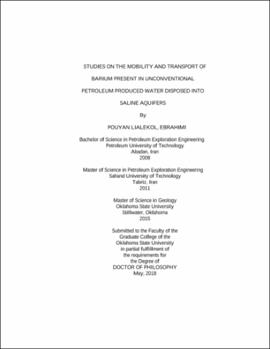| dc.contributor.advisor | Vilcaez, Javier | |
| dc.contributor.author | Ebrahimi, Pouyan Lialekol | |
| dc.date.accessioned | 2021-05-25T21:08:57Z | |
| dc.date.available | 2021-05-25T21:08:57Z | |
| dc.date.issued | 2018-05 | |
| dc.identifier.uri | https://hdl.handle.net/11244/330015 | |
| dc.description.abstract | Petroleum produced water (PPW) from unconventional oil and gas (UOG) in the USA contains heavy metals whose concentrations are in many cases hundreds of time above the USA drinking water standards. This poses an environmental risk as PPW injected into deep saline aquifers might migrate to underground source of drinking water (USDW). | |
| dc.description.abstract | For my dissertation, I have investigated the mobility and transport of barium (Ba) in sandstones and dolomites under the presence of guar gum and at typical concentrations of NaCl, Ca, and Mg in PPW from UOG reservoirs. Ba was selected because it constitutes the most common and abundant heavy metal found in the PPW from UOG reservoirs, guar gum was selected because it represents the most common organic additive used in viscosified fracturing fluids, and dolomites and sandstones were selected because they constitute the most common geological intervals containing saline aquifers where PPW is disposed in Oklahoma. To unveil the variables controlling the mobility and transport of Ba at deep saline aquifer conditions, I conducted batch and core-flooding experiments using powdered dolomites and sandstones (500-600 um particles sizes), uniform synthetic and natural intact/fractured dolomite and sandstone core plugs (2.54 cm diameter and 4-10 cm length) at 22 and 60°C. To interpret and understand the experimental results, I conducted computational studies using CrunchFlow and TOUGHREACT geochemical reactive transport simulators. | |
| dc.description.abstract | The results of the conducted experimental and computational studies revealed that brine salinity (NaCl) followed by the competition of cations (Ca and Mg) for binding sites, pH that results from dissolution/precipitation reactions of minerals, and to a less extent temperature control the sorption and thus the mobility of Ba in dolomites and sandstones. I found that presence of guar gum in PPW retards the transport of Ba through low permeability dolomites but not through high permeability sandstones. The higher Ba sorption levels attained in dolomites than in sandstones results in a faster transport of Ba through porous sandstones than through porous dolomites. However, the higher dispersion transport of Ba in fractured sandstones than in fractured dolomites can result in faster transport of Ba through fractured dolomites than through fractured sandstones. | |
| dc.description.abstract | The partition coefficients and reactive transport models proposed in this dissertation can be used to assess the risk of USDW contamination by Ba, on the case by case basis. | |
| dc.format | application/pdf | |
| dc.language | en_US | |
| dc.rights | Copyright is held by the author who has granted the Oklahoma State University Library the non-exclusive right to share this material in its institutional repository. Contact Digital Library Services at lib-dls@okstate.edu or 405-744-9161 for the permission policy on the use, reproduction or distribution of this material. | |
| dc.title | Studies on the mobility and transport of barium present in unconventional petroleum produced water disposed into saline aquifers | |
| dc.contributor.committeeMember | Puckette, Jim | |
| dc.contributor.committeeMember | Halihan, Todd | |
| dc.contributor.committeeMember | Lampert, David | |
| osu.filename | Ebrahimi_okstate_0664D_15679.pdf | |
| osu.accesstype | Open Access | |
| dc.type.genre | Dissertation | |
| dc.type.material | Text | |
| dc.subject.keywords | barium | |
| dc.subject.keywords | deep saline aquifers | |
| dc.subject.keywords | dolomite and sandstone | |
| dc.subject.keywords | fracture | |
| dc.subject.keywords | petroleum produced water | |
| dc.subject.keywords | temperature | |
| thesis.degree.discipline | Geology | |
| thesis.degree.grantor | Oklahoma State University | |
